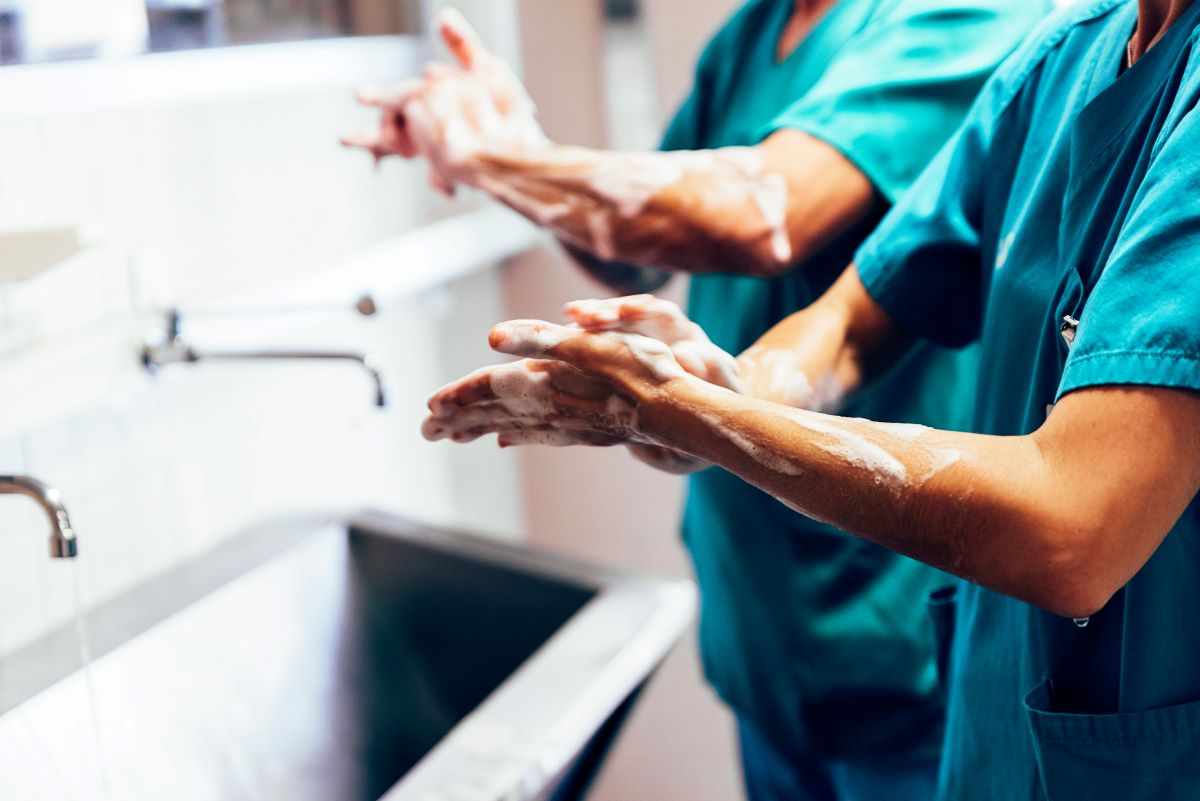Using a Hand Hygiene Audit Tool: Facility Guide and FAQ

Healthcare-associated infections significantly increase morbidity, mortality, and treatment costs. Using proper hand washing techniques can reduce the transmission of infection while keeping patients, families, and healthcare staff safe and healthy. A hand hygiene audit tool can help facility leaders assess staff handwashing compliance and highlight opportunities for improving handwashing practices.
In this article, we review the importance of hand washing, explain how monitoring staff hand washing techniques can improve health outcomes, and describe different hand hygiene auditing tools your facility can use to optimize patient safety and improve quality of care.
Why Is Handwashing Important?
Nearly 10% of all hospitalized patients contract a preventable healthcare-acquired infection (HAI) during their stay. These healthcare-acquired infections, called nosocomial infections, kill nearly 90,000 patients each year and increase annual hospital medical expenses by $4.5 billion.
According to the Centers for Disease Control (CDC), high-quality hand washing is the most impactful way to reduce the transmission of infection in healthcare facilities. Hand hygiene can be encouraged through:
- Purposeful placement of sinks and alcohol-based gel hand sanitizer dispensers.
- Continuing education modules focusing on HAI reduction strategies.
- Promotional posters and pamphlets in facility common areas and restrooms.
While these strategies help individuals perform hand hygiene, they do not help determine whether appropriate hand washing is actually being carried out. Facility leaders can assess hand washing compliance and improve infection control practices through the use of a hand hygiene audit tool.
For nursing homes, hospitals, clinics, and other care facilities, these hand washing audits can reduce preventable infection, increase patient satisfaction scores, and increase federal reimbursement from Medicare and Medicaid.
What Are the World Health Organization’s 5 Moments of Hand Hygiene?
Audit tools can help facilities determine where and when staff members are washing their hands and help devise quality-improvement strategies to reduce infection transmission. Frequency and timing of hand washing are the most important factors for reducing HAI; therefore, many facilities audit for these variables to identify areas of weakness.
The World Health Organization (WHO) highlights five key opportunities for performing hand hygiene to reduce patient infection:
- Before touching a patient
- Before a procedure
- After a procedure or body fluid exposure risk
- After touching a patient
- After touching a patient’s surroundings
Healthcare staff who fail to comply with hand washing procedures during these instances significantly increase the chances of infection transmission to patients in their care. It’s important for healthcare organizations to periodically perform hand hygiene audits to ensure that all staff members are cleaning their hands at the appropriate time and in the correct way.
What Is a Hand Washing Audit?
Healthcare facilities often use surveys and checklists to obtain vital data necessary for care improvement. A hand washing audit can be completed by facility staff or volunteers to assess how well hand hygiene is performed in places like hospital common areas and individual patient rooms.
Each hand hygiene audit checklist should include:
- The name and role of the individual performing the audit.
- The month, year, and location (hallway, cafeteria, lobby, patient room, etc.) of audit completion.
- The type of healthcare worker observed (nurse, medical assistant, physician, unit secretary, etc.).
- The type of practice being observed (soap and water sink washing, alcohol-based gel hand sanitizing, sterile glove change, etc.).
It might be helpful for facilities to know if hand hygiene practices differ between day shift and night shift. Also, knowing if soap and hand sanitizer dispensers are often empty could unveil possible root causes of poor hand washing practices. Facilities leaders should tailor additional hand hygiene audit tool categories to fit the needs of their organization.
How Can Hand Hygiene Audit Tools Improve Patient Safety?
When hand hygiene is performed correctly by healthcare staff, the incidence of healthcare-associated infections drops by up to 50%. Unfortunately, despite significant hand hygiene training and education efforts, 40% of healthcare employees don’t routinely adhere to proper hand washing technique.
Hand hygiene auditing can point out deficiencies in practice and help facility leaders better understand why these breakdowns occur. They can also help facilities meet national hand hygiene standards by highlighting the need for new staff training modules or redesigned facility spaces.
Disseminating audit results with hospital administrators, unit managers, and clinical staff can spark root cause analysis discussions and encourage quality-improvement projects in hospital units. Involving the multidisciplinary medical team, janitorial staff, and hospital volunteers helps to address concerns from all angles.
Hand hygiene auditing should not be seen as punitive. Its main purpose is to help develop significant change efforts for improved infection prevention practices across organizations and facilities.
What Are Some Hand Hygiene Observation Tool Examples?
Now that you understand the importance of hand washing and hand hygiene auditing, you might be looking for some example tools to help get your facility started. We’ve listed a few high-quality hand washing monitoring tools below to start you on your journey toward providing better and safer care to your patients.
|
|
|
|---|---|
| CDC Hand Hygiene Audit Tool | Allows hand washing monitors to document hygiene observations from multiple spaces, including common areas and areas around each patient’s room
Provides space to write notes and give additional comments for each monitored staff member |
| WHO Hand Hygiene Monitoring Tool | Facilitates documentation of every opportunity included in the “five moments of hand hygiene”
Helps facilities keep a record of where hand washing is missed in the care process |
| ASC Hand Hygiene Observation Record | Created to monitor hand washing practices before, during, and after patient care in outpatient surgery centers
Its application also extends to acute care hospitals, nursing homes, and other care facilities |
Want to Learn More Ways to Optimize Care Quality at Your Facility?
Healthcare infections can be expensive and deadly. By using a hand hygiene audit tool, facility leaders can improve care quality and ensure that their facility’s infection control practices are up to date. For more expert tips on how to keep your patients and staff safe, healthy, and happy, follow our free IntelyCare newsletter.

